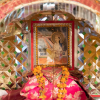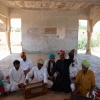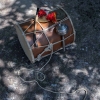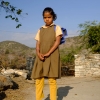Interviewee: Dr. Bijoy Kali Mahapatra
Interviewer: Barnamala Roy
Camera, Editing: Bishwadeep Mitra and Annapurna Banerjee
Barnamala Roy: How did ornamental fish attract your curiosity? Also, why and how did you select ornamental fish farming as your subject of research?
B.K. Mahapatra: In my university days, Prof. Dr. N.C. Dutta (while teaching composite fish culture) talked to us about several small ‘undesirable’ fish residing in the waters of India, which need to be eradicated so that food fish like rohu and katla can thrive. But he also informed us that these fish were in high demand in foreign markets. Since then, I became acquainted with the commercial value of these indigenous species which has helped us identify them as Indian ornamental fish.
In 1977, Professor Dr. Hiralal Choudhury (known as the father of ‘induced fish breeding’ in India ) explained to us how we can earn through ornamental fish farming, and also take it up as an area of research.
Ornamental fish farming was a dream for me, and there are many ways in which I realized it. Incidentally when I went to Israel around 1994-1995 for training and visited the ornamental fish farms, I came in contact with a world renowned expert in ornamental fish. There I also met a German friend to whom I expressed my interest in ornamental fish breeding. He was rather derisive about the prospect of ornamental fish farming in India, given our economic standing, and asked me to rather concentrate on the production of food fishes. I felt a little insulted, and noted down in my diary the promise to dedicate myself in increasing the prospect of ornamental fish farming in India. To realize this, I have changed my lifestyle; I wake up between 3-4 a.m. every morning to study for my research on ornamental fish.
In 1988, when I was posted in Nimpith (Sundarbans, West Bengal) as a Scientist of Ramkrishna Asram Krishi Vigyan Kendra, I began to collect and keep records of small fish (having ornamental value) residing in the rivers, creeks and channels of the region. Eventually, I went on to publish a complete list of indigenous fish from across West Bengal with their names and characteristics.
After this, I was posted at the Freshwater Fishery Training and Research Center in Kulia, Kalyani in 1997. There, I started exploring the ways of breeding more and more varieties of fish. Since, there were no separate funds available round that time for cultivation of ornamental fish, a student, Naren Santra and I started rearing a few angel fish on our own. Before that the popular belief was that angel fish cannot be bred in captivity in West Bengal, since, it is imported after sterilization. I decided not to put my belief in that, and went by the definition of ‘re-search’ which means searching again. I put the angels in an aquarium, and one day, found a fish closely trailing another. This implied that they had started choosing their partners, and we were assured that they would breed soon.
B.R.: Were you the first to identify the gender of these fish (whether male or female) by observation? I presume, there were no accounts or related literature regarding the same prior to that in India?
B.K.M.: Yes. We learnt to identify prospective couples among the fish and started to keep them separately for closer observation. Eventually one day, we saw a (male) fish clearing the filter tube, and its (female) partner laying eggs.
B.R.: And, where did you observe the coupling first?
B.K.M.: Inside aquariums at the Kalyani Research Center. I was the first to effectively breed angel fishes in captivity in India, and to officially publish the success story in a journal. The Fisheries Minister, Kironmoy Nanda recognized my efforts and offered me ample encouragement in my initiatives on ornamental fish farming. He told me that the scientific reports published by the researchers are of little help to the fish farmers. My senior officer, Dr. Kamal Sengupta also proposed that I write about the colourful ornamental fishes in Bengali.
B.R.: Apart from the fish farmers, there are hobbyists who keep and raise fish at home and are instrumental in sustaining the market demand for ornamental fishes. Are there any journals and books for them, from which they glean information related to aquarium fish and their maintenance?
B.K.M.: There are some international books and journals on this, but they are mostly not available to the common public in India. For many, they are inaccessible in terms of language. Also, the existing literature describes conditions of maintenance of ornamental fish in foreign climates making them of little help. We have started producing manuals and books in regional languages to help the hobby grow in India. Compiling facts and my own experience of ornamental fish farming, I have written the book, Rangeen Macch Projonon O Chash (Ornamental Fish Breeding and Cultivation) which can benefit fish farmers, researchers and hobbyists alike.
B.R.: Where are these books/journals available, and how do you popularize these books among the public?
B.K.M.: These books are sent for sales and public display at various ornamental fish fairs and symposiums by the Fishery Institutes.
B.R.: In places outside India (Germany for instance), there are various fish societies and clubs to circulate or share knowledge of fish keeping. Are you planning such associations in India?
B.K.M.: India was lagging behind in terms of organization in spite of a long history of fish keeping as hobby among its populace. Many governmental and private societies have started emerging here, now, and the state and central fishery institutes are conducting training programs to aid them. Case in point is Howrah Ornamental Fish Association. The government of India has provided much support in establishing infrastructure for breeding ornamental fishes through the National Bank for Agricultural and Rural Development (NABARD), the National Fisheries Development Board (NFDB) and the Marine Products Export Development Authority (EMPEDA).
B.R.: What I came across while researching the history of aquarium fish farming (and keeping) is that the hobby first started from imported fish. The British first brought varieties of gold fish, guppies and mollies to India. Was the hobby learnt from fish cultivators abroad, or does the hobby predate that?
B.K.M.: Even before imported varieties became popular as pets in households, the ancient kings and members of the aristocracy cultivated fish keeping as a leisurely pursuit. Local fish could be found swimming in garden pools of their courtyards, which in English terminology, are known as ‘vivaria'.
B.R.: Is it a popular misconception that the British were the initiators of the hobby among the indigenous population? Are there any official documents supporting/challenging the same?
B.K.M.: The British brought the imported varieties. Official records have not been published on this, but kings and zamindars in various provinces of West Bengal and India, kept Rui (Rohu), Katla, Shingi and Magur (stinging and walking catfish) in their vivaria before that.
We have, for some time, produced increasing varieties of local fish through selective breeding by ‘value addition’. Organized research has maybe started almost a thousand years later in India, but we are now utilizing the huge resources we have in terms of germplasm. This contributes to the great demand in Indian varieties like ‘Chanda’ or the Indian glass fish, gouramis and loaches in world market. What started out as a hobby among the native population has gradually developed into a widespread occupation.
B.R.: Could you tell us briefly about the indigenous/native communities who have taken up this livelihood in India?
B.K.M.: The fish which were imported from abroad, slowly got acclimatized to the environment here and reached maturity. People in areas like Howrah, Hooghly, South 24 Parganas, North 24 Parganas started rearing both these imported and local varieties. Kerala, Tamil Nadu too has a considerable population involved in this trade. But West Bengal ranks first in colourful fish production; more than half of the population in India involved in occupations related to ornamental fish are based in this State. The trade supports more than 20,000 families in West Bengal, and the Howrah region alone is home to 1200 of them.
But, what incited so many of them to take it up as an occupation? Why did this emerge in the suburbs? As I said, it first came to the suburban regions of India and West Bengal as a hobby and then expanded into an occupation. After cultivating these fish for passion, the farmers here began to look for ways to breed these fish so that they do not have to buy spawns repeatedly. Now, they began to find ways to generate income from the fish they were producing.
B.R.: So, first they had to buy the imported spawns right, before they could start breeding them?
B.K.M.: Yes, they first had to buy the imported species. But there's another side to this. Various communities of fishermen had already started to collect the Indian ornamental varieties locally and started selling them.
B.R.: How did the different fishery institutes (state and central) reach out to the different indigenous communities?
B.K.M.: We started a regular training program from the institutes which ideated on how to breed ornamental fish effectively. In this regard, the State Fisheries Research Center, Central Inland Fisheries Research Institute (CIFRI), Central Institute of Freshwater Aquaculture (CIFA) i.e. the ICAR organizations have provided active support. When I was transferred to Shillong from Kulia (Kalyani), the government of India supported a ICAR/NATP/CGP research project, for which I bred, cultivated and developed a database of ornamental fish living in the springs of the North Eastern Hilly regions.
B.R.: But there are communities in the North Eastern Hilly regions who were already cultivating the ornamental fish locally, right? Were they self-taught, or did they learn from the training programs conducted during these projects you mentioned?
B.K.M.: Obviously, they were all self-taught to some extent. What we did was start a routine training process. We, from CIFE (for instance), began extending the course from three to seven to forty- five days. Already we have organized around twenty-five to thirty courses.
B.R.: Did you help form he fish farmer associations or did that happen spontaneously (by self-organization)?
B.K.M.: More than the central, the state government in West Bengal was initially more instrumental in organizing the cooperative societies of fish farmers. Apart from the societies which were initially involved in fish spawn production or fish rearing, the state government encouraged formation of women cooperatives for ornamental fish farming.
B.R.: And the central institutes then trained them?
B.K.M.: Both the central and state centers conduct trainings. A five day training course is organized at the state level for cultivation and breeding of ornamental fish. ATMA also came forward to conduct training programs on ornamental fish cultivation at block level. At every Fish Institute, there are two outlets on ornamental fish, where the entrepreneurs can come for training and bring their fish for export.
B.R.: Even outside these self-help groups, there are independent fish farmer, retailers (entrepreneurs) involved in this livelihood. How do they learn?
B.K.M.: In spite of its popularity, ornamental fish farming as an occupation was largely unstructured for long, so it is yet to receive wider acknowledgement. No institution has been founded to research exclusively on aquarium fishes, we research or conduct training programs on it along with our normal day to day work. But slowly with organization of this sector, we are making databases of the families involved in this trade, and the income they make from it. In Howrah (where the Howrah Ornamental Fishery Association has been formed) , every other family is cultivating ornamental fish.
B.R.: Do trainers appointed by the institutes also get to learn from the fish farmers say in Howrah? (Because training can be of kinds, I presume -- academic training and those who are self-taught, i.e., the farmers.)
B.K.M.: Certainly. Those who are rearing it in ponds are equipped with much better practical facility. The farmers raise the fish in an ecosystem much more conducive for their proliferation, so the scientific technology we are developing in the institutes for induced breeding actually originates from them. For example I started breeding the angel fish in aquariums first, but the mass scale propagation was carried out by the fishermen.
The fish farmers try to prepare organic food from natural resources for the fish while we often feed them Artemia. They are refining the technology for efficient and more profitable fish cultivation by the farmers.
B.R.: What would you say are the differences and similarities in regulating the food and water for fish in the institutes, and outside the institutes among independent practitioners or fish farmer associations?
B.K.M.: In the institutes, we train (researchers, fish enthusiasts and farmers alike) to prepare artificial feed, as well as live food culturing for ornamental fish. But most fish farmers collect daphnia and earthworms from the local ponds to feed the fish. These are very good food but we are also making artificial feed to keep provisions ready in case daphnia worms are unavailable. To maintain the brightness in the fish's body colours, we are mixing hibiscus and marigold flower petals with the artificial food.
A fish cultivator has to change the water in which the fish swim a number of times. To aid this process we are devising some systems like the Recirculatory Aquaculture System that purifies the water within the system so that it can be reused many times.
B.R.: So this system can be implemented in the natural ponds too? I have mostly seen these fish being raised in ponds. Ponds, tanks and what are the spaces conducive for ornamental fish cultivation?
B.K.M.: For mass scale production, ponds or wetlands rather than tanks and aquaria are being used for large scale production of fish. The fish are directly released in the pond water, or they are kept in mosquito net enclosures within the ponds. Food fish like Pona, Tilapia and colourful fish can be simultaneously reared in these ponds, so this livelihood is thriving.
B.R.: If you could talk about the professions associated with ornamental fish (apart from farming), and their incomes...
B.K.M.: The people associated in ornamental fish farming and trade can make Rs. 5,000 to 20,000-30,000 monthly income from these fish. Apart from the twenty to twenty-five percent people engaged in fish breeding, there are food preparers for ornamental fish and manufacturers of aquariums, toys, models and equipments needed to maintain an aquarium. In the Howrah region especially, a huge number of women have become involved in these occupations. Some of them oversee the packaging of these fish (for export and domestic sales). Others are farming and collecting plants from water bodies required to make up the natural ecosystem of aquariums.
B.R.: Academics and researchers, on the other hand, are often saying that since India is economically backward, it is better to cultivate food fish than ornamental varieties. What would be your opinion on this?
B.K.M.: I would not say that economic backwardness has got anything to do with this. Because people here have no dearth of hobbies, and ornamental fish keeping is a healthy pastime. Rather, it has been identified as the second largest hobby in the world. We have calculated to find that Das Nagar in Howrah trades up in 35-40 lakhs every day. Besides, the weekly market in Kolkata's Galiff Street is also involved in ornamental fish trade, where the domestic market is crossing 1,200 crores. So, this assumption is mostly wrong which you can confirm if you go to Howrah where a huge population is engaged n occupations involving colourful fish.
Again, ornamental fish farming is such an occupation that it can be started on no-cost technology. I was able to create a model of this. While posted at Kalyani, I have written books on ornamental fishes. My studies and initiatives are mostly based on experience and understanding of ornamental fish farming. We raised a few guppies in a drain, and then sold the beautiful males in the Haati Bagan Market to generate capital. After that we bought spawns of gouramis and fighters, and started raising them in old pots. Plankton for fish feed was collected in nets made out of the tattered drapes (‘dupatta’/ ‘orna’) belonging to the cultivators' sisters. So, you can see that it is possible to set up a no-cost technology for ornamental fish farming by devising such methods as raising the spawns in drains, keeping them in old pots/utensils and using frayed dupatta as nets.
B.R.: So, there can be a very big future for this occupation, and many initiatives can be further taken on this.
B.K.M.: One student also raised fighter fish in the saline bottles he obtained from a hospital doctor. We successfully bred a lot of imported varieties with organic feed prepared locally, which had not been possible earlier. Not only in aquariums or tanks, today it is possible to raise aquarium fish in neighbourhood ponds. I can show you one such ecosystem we prepared in the neighbourhood to raise fish.
B.R.: You have created this pond yourself?
B.K.M.: Yes, with my own hands.












